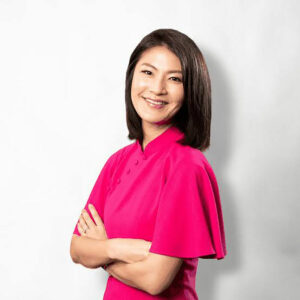By Aubrey Rose A. Inosante, Reporter
PHILIPPINE BRANDS should leverage co-creation with influencers to deliver more authentic marketing messages, according to global marketing consultancy firm Ogilvy.
“The trap that many brands fall into is wanting creators to merely mouth their brand messages. There’s no soul. It’s not authentic. I think co-creation with creators is going to be very key,” Emily Poon, president for Asia-Pacific at Ogilvy Public Relations, said in an interview with BusinessWorld.
Ms. Poon said that “co-create” means working closely with creators to reflect their authentic creative voices in brand campaigns, as they are already trusted by their followers.
This comes as brands aim to engage with the “creator economy,” where 50 million content creators globally are expected to generate $500 billion by 2027.
“We have a lot of clients coming to us wanting social buzz, influence buzz, creative, creator-led campaigns,” Ms. Poon said.
She noted that aside from macro celebrities, brands now collaborate with influencers with niche interests to create 30-second cutdowns to promote products or initiatives.
“Creating moments where people can talk about becomes viral. It means that we’re linking social influence and commerce, and eventually, it results in conversion for the brand,” she said.
However, Ms. Poon warned that creators sometimes attract controversy or become subject to cancel culture due to inappropriate current or past actions, which could derail a campaign.
“That’s why we are launching this new offer called Influence Reputation, where we look at end-to-end management of influencers. We have tools in place, proprietary tools, to do thorough research,” she said.
Ms. Poon also noted that the Philippine advertising industry is experiencing an exciting period due to recent innovations and shifts in how Generation Z engages with information.
She said this audience wants to align with brands that have values. “I like to think of it as three Cs: community causes, culture, and channels, i.e., the platforms they are on,” she said.
For the Philippines, Ms. Poon mentioned a campaign called House of Healers with Mind You Mental Health Systems, which addresses mental health in the country, especially in the gaming community.
She said 3.6 million Filipinos suffer from mental health conditions, and 97.3% of them are gamers. In the game sector, professionals play as healer characters and offer consultations.
VIRTUAL AND AI INFLUENCERS“The Philippines is very much our content hub. We produce a lot of content here for the world and the region, but Vietnam, in this case, is our virtual influencer hub. There is a lot of promise for virtual influencers, and it’s a good complement to human influencers,” Ms. Poon said.
Among these virtual ambassadors is Minah, Southeast Asia’s first healthcare virtual influencer, launched by Ogilvy in Vietnam for the brand MSD. She educates the public on human papillomavirus, a common infection spread through sex.
“Sometimes it is considered a taboo topic to discuss openly, that’s why a virtual influencer is so relevant, because at the end of the day, you’re chatting with technology,” she said.
However, Ms. Poon said that while virtual influencers show promise, they do not replace humans; they exist alongside human influencers and help address the limitations of human engagement.
Artificial intelligence (AI) influencers aim to solve problems such as time-consuming, one-on-one interactions, influencers going off-brand, celebrity scandals, rising geopolitical implications, and current engagements limited by contracting periods for personalities or celebrities, she added.
Minah is among the 200 virtual influencers globally owned by agencies. Ms. Poon mentioned that brands such as Ikea have partnered with Japan’s first virtual model and social influencer, Imma.
Another virtual influencer is E.M., a collaborative product between Ogilvy T&A and animation and 3D studio Colory. She has her own social media accounts and collaborates with local brands.
Ms. Poon likened the appeal of virtual influencers to “tamagotchi,” where people resonated with the digital pet even though it is an inanimate object.
“Virtual influencers are very much like human influencers. To resonate with a community, you need to have like-minded interests and passions to relate to them,” she said.
“Very often, don’t forget, behind an AI influencer is still a human team. A virtual influencer will also stand for some causes.”
For virtual influencers, it is important that we disclose. Ogilvy feels very strongly about this, so much so that with the launch of the AI Accountability Act globally, she said, adding that the firm would require brands it works with to publicly declare the use of any AI-generated influencer content.
She also mentioned an Ogilvy campaign for Mondelēz, the maker of Cadbury Dairy Milk chocolate, that featured Bollywood actor and film producer Shah Rukh Khan. His likeness was used to generate personalized advertisements for small businesses.
In the “Not Just a Cadbury Ad” campaign, the businesses were given the power to create their own versions of the advertisement, powered by a machine learning program to recreate the actor’s face and voice and include the local store names in the ads.
“This was rolled out around 10 major cities in India. It’s called AI-powered hyper-personalized ads,” she said.
Besides her position at Ogilvy, she also sits on the AI Advisory Board for the Singapore Institute of Technology and the Industry Advisory Council for the Department of Communications and New Media at the National University of Singapore.
Ms. Poon, who has 20 years of experience in corporate reputation, integrated marketing, and strategic communication, said virtual influencers are not just a fad but show a lot of promise for the industry.
She earned a Bachelor of Business Management with double majors in marketing and law from Singapore Management University and eventually found her way into public relations.
“When I first joined, I didn’t know what public relations was. But then when I helped companies and brands tell stories, I fell in love with storytelling,” Ms. Poon said, noting Ogilvy was her second agency to work for.
During her 16-year tenure at Ogilvy, she became the youngest and first female head of the company, managing a team of 1,000 across 13 Asia-Pacific markets.
When asked about overseeing 13 markets, she highlighted the diversity of the Asia-Pacific region. “It comes down to empathy. It’s essential to understand that there’s no one-size-fits-all solution. One must be empathetic to the unique perspectives and needs of each market,” she said.






